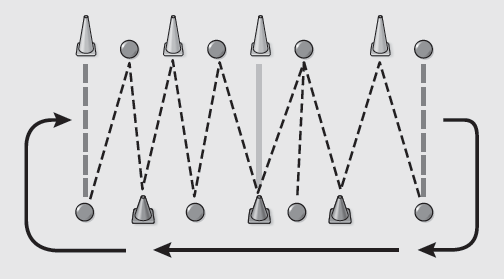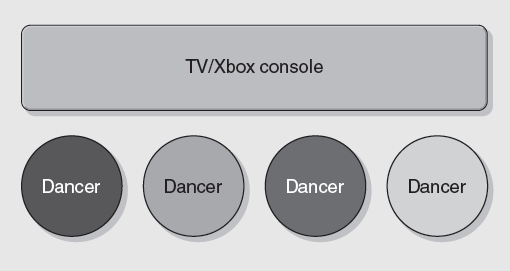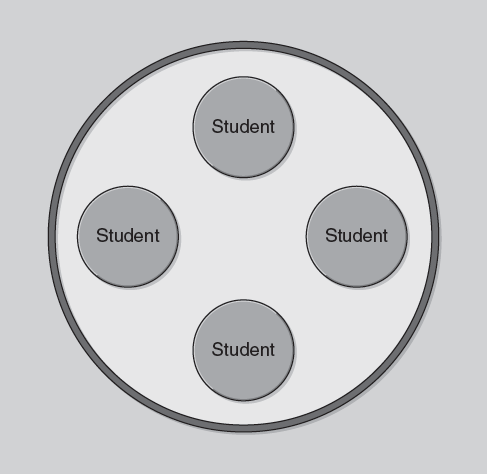Universally Designed Lesson Plans for Fitness
This is an excerpt from Universal Design for Learning in Physical Education With Web Resource by Lauren J Lieberman,Michelle Grenier,Ali Brian,Katrina Arndt.
By Matthew J. Patey, Jenna Fisher, and Laurie Wengerter
Lesson 1: Stations
Fitness Stations
Grade Level: 2-4
National Standards
Standard 3. The physically literate individual demonstrates the knowledge and skills to achieve and maintain a health-enhancing level of physical activity and fitness.
Grade-Level Outcomes
S3.E2.2. Engages actively in physical education class in response to instruction and practice.
S3.E2.3. Engages actively in the activities of physical education class without teacher prompting
S3.E2.4. Engages actively in the activities of physical education class, both teacher-directed and independent.
Introduction
Time: 5 minutes

Figure 11.1 Fitness stations.
Description: The following activities use five stations set up throughout the gym (see figure 11.1). The students are in small groups and rotate through each station on the teacher's signal.
Organization/rotation cues: The teacher explains to the students that the class will be divided into five groups, with one group at each station. Every group will be able to participate in each station during the class period. The students move clockwise in the gym to each station, which will have a large cone with the station number, activity, and a few critical cues. The timing of the stations is controlled by the music at station number 2; everyone rotates after each song. Each song is approximately three minutes long, so it is possible to do the stations multiple times. If the students repeat a station, they are encouraged to try something new and challenging.
Activity Station 1: Rope Maze
Time: 3 minutes
Description: The teacher sets up different-sized cones approximately 20 feet apart throughout the entire gym. Each cone is connected to another by the handle of a jump rope inserted into the top hole of the cone to create a “rope maze.”
Rules: Students may go under, over, or around the rope maze from start to finish. With the goal of not touching the rope with any of their body parts, the students can choose any pathway and body position they would like to move through the rope maze. If a cone or rope becomes loose, the student must fix it before leaving the station or before the next person goes through the maze.
Rotations: The students are in a variety of small groups, with a different group at each of the five stations in the gym. There will be approximately five to six students at a station, depending on the class size. At this station, the students form a line behind the starting line. The next student starts when the student in front of them reaches the middle of the rope maze. When the student finishes the rope maze they travel in any way they choose to move back to the starting line. Students are at each station for approximately three minutes before rotating to the next.
Starting line: Green jump rope
Middle: Yellow jump rope
Finish: Red jump rope
Cues:
- Pace yourself: comfortable pace
- Low level: get as low as possible to the ground
- High level: get as high as possible off the ground
- Medium level: travel at your typical height
Teacher behaviors: Teachers can encourage students to use different movements to move through the maze at varying levels.
Activity Station 2: Dancing
Time: 3 minutes
Description: The teacher sets up a TV monitor connected to Xbox Kinect and chooses a dancing game such as Just Dance Kids 2014. The teacher sets up poly spots evenly spaced on the ground in front on the console so that all of the students have their own personal space and view of the TV screen. The students then mirror the dancers on the game console for one full song. The teachers can also encourage students to put their own “flare” on the movements that may be more impactful for them.
A DVD or video found on YouTube and projected onto the gym wall can serve as an alternative.
Rules: The students must stay in their own personal space by staying on the poly spot they have chosen.
Cues:
- Mirror: Pick one person on the screen to mirror
- Add Flare: Include your personal touch and self-expression
- Prepare: Watch the bottom right corner of the screen for the next move
- Smooth: focus on a smooth transition between movements.
Organization: See figure 11.2.
Teacher behaviors: The teacher observes the students for mirroring of movements, addition of student flare, and rhythm.

Figure 11.2 Dancing activity.
Activity Station 3: Balance
Time: 3 minutes
Description: The teacher sets up six balance beams/lines (approximately eight feet long and four to six inches wide); two are traditional floor beams, two are slacklines, and two are floor taped lines (or jump ropes). The teacher begins by demonstrating how to travel on the balance beam using different movements such as pushing your wheelchair or walking using forward and backward directions. Each student moves across the balance beam, slackline, or line that they choose varying their directions and movements. Before each beam are task cards that show the parts of each movement that the students can choose to perform.
Rules: Only one student may be on the beam and the mat at a time for safety reasons. The students can choose any way they want to travel across the beam, in addition to the type of beam, that will allow them to complete the task successfully.
Cues:
- Balance beam
- Move slowly
- Arms out to the side to help with balance
- Chin up
Organization: See figure 11.3.

Figure 11.3 Balance activity.
Activity Station 4: Keep It Up
Time: 3 minutes
Description: The teacher may use the existing basketball court or set up disc cones to create a playing area. The students have the option to choose a ball from a variety of sizes and weights (beach ball, balloon, soft volleyball, etc.). The whole group must work together to keep the ball in the air without letting it touch the ground. They can count by using different math skills (counting by 1s, 5s, etc.) or using the alphabet (going alphabetically or spelling different words).
Rules: The students cannot make contact with the ball more than two times in row and must remain in the boundaries of the playing area to avoid interfering with the other stations.
Variations: Students must hit the ball in a certain order. Students can only make contact with the ball once. Students use various body parts to hit the ball.
Cues:
- Soft touches
- Push high
- Communication: Call for the ball—“I got it,” “Mine”
Setting goals: Teams can set their own goal, whether it be time-based, by level (high, medium, low), or number of hits before dropping. Goals can include a drop in between, if needed.
Organization: See figure 11.4.

Figure 11.4 Keep It Up activity.
Activity Station 5: Flash Card Scooters
Time: 3 minutes
Description: The teacher selects flash cards that match the students' math levels (a variety of difficulty) and put them scattered in a section of the playing area. The teacher also displays poly spots that are numbered 0 to 9 in the playing area. The students use scooters or wheelchairs, or slide on a carpet square, to move to the flash cards and select one that is the appropriate level of difficulty for them. The student then solves the equation and moves over to the answer by rolling over or sliding to the numbers on the ground (numbered poly spots). Once the equation is answered, the student replaces the equation card where they found it, then continues grabbing flash cards and solving them until the time is up.
Rules: The students can work together or separately. The students must be on the scooter, carpet square, or wheelchair at all times and are not allowed to stand on them. The students should avoid bumping into each other.
Cues:
- Sitting
- Bottoms on the scooter, carpet, or chair
- Hands on the handles or wheels
Organization: See figure 11.5.

Figure 11.5 Flash card scooters activity.
Universally Designed Components
Multiple Means of Engagement
- Student choice is important in this lesson. The distances, speed of activity, size of equipment, and number of trials is up to each individual student or negotiated in their group. Student groups are encouraged to work together and to consider each individual's requests and needs.
Multiple Means of Representation
- The teacher presents the instructions for the activities in multiple manners—visual (demonstration and station cards), auditory, and tactile (if needed)—and reiterates them as needed.
Multiple Means of Action and Expression
- Students make decisions on their own or within a group about how to be successful in the activity. Each student's level of success is determined by the student.
SHOP

Get the latest insights with regular newsletters, plus periodic product information and special insider offers.
JOIN NOW
Latest Posts
- Using double inclinometers to assess cervical flexion
- Trunk flexion manual muscle testing
- Using a goniometer to assess shoulder horizontal adduction
- Assessing shoulder flexion with manual muscle testing
- Sample mental health lesson plan of a skills-based approach
- Sample assessment worksheet for the skill of accessing valid and reliable resources


